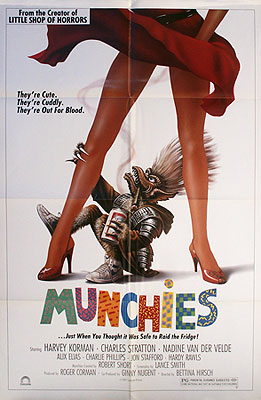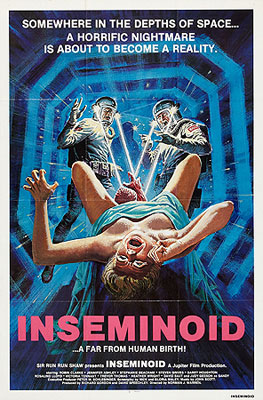Mockbusters: The Limitless And Lazy World Of Rip-Offs
Published on May 30th, 2011 in: Climb Onto The Nearest Star, Issues, Movies, Science Fiction, Underground/Cult |By Eric Weber
“Gremloids?”
“No, Mom. Gremlins. It’s about these creatures that take over a town. It’s really good.”
“Gremlins?”
“Yes. There should be this sort of . . . lizard monster on the front of the box.”
“Ok. Well, I’ll see if they have it.”
It was my thirteenth birthday and I was planning on having some friends over to watch one of my favorite movies. However, when Mom came back from the store and dropped the craggy, sun-bleached box on the dining room table, I thought I was going to cry.

“Here you go!” she chimed. I looked at the box and saw an illustration of a creature holding a beer, smoking a cigarette, and looking up a woman’s skirt.
“Mom. This is MUNCHIES! Not Gremlins!”
“Well, you said a little monster! Oh, forget it. Next time you go and get what you want. All those boxes look the same to me.”
Cha-ching! That’ll be $2.99, please. Thank you very much and have a nice day. Score one point for the rip-offs, zero for the consumer.
That fleeting memory leads me to the topic of one of my favorite subgenres in film—the rip-offs. The Merriam-Webster dictionary has a great definition for rip-off: “a usually cheap, exploitative imitation.” I love that it says usually cheap.
The idea and business sense behind a rip-off is really quite brilliant, misguiding those people (like my mother) who pay no attention to detail, roping them in using their peripheral awareness of a more successful product.
You see this in all facets of consumer spending. From breakfast cereals (General Mills’ Lucky Charms vs. generic Marshmallow Treasures), cookies (Nabisco Oreos vs. Kroger brand Kid-O’s!), toys (Cabbage Patch Kids vs. Cauliflower Kids . . . I’m not making that up) and, best of all, at the movies.
The recipe is simple. Take a popular film, identify the most exploitable elements—usually the sex and violence—and then create a whole new movie around that. The basic plot and setting can stay the same but a slight variation will work as well. Cast the film with some recognizable faces, like former TV stars or international actors, and top it off with a title that slightly alludes to the original production.
The horror film is the most accomplished genre to utilize the business plan of the rip-off, the slasher subgenre being the perfect example of this practice. Following at a close second are science fiction films. Thanks to popular titles like 2001: A Space Odyssey (1968), Star Wars (1977), and Close Encounters of the Third Kind (1978), the genre was redefined and upgraded from B-pictures to legitimate and valuable Hollywood properties.
The success of these movies also helped create entirely new subgenres based solely on the memorable scenes and ideas from these original films. One particular film is responsible for spawning the most imitations and copies: Ridley Scott’s Alien (1979). If imitation is the sincerest form of flattery, than Alien could be considered the “belle of the ball.” This is no doubt due to the breathtaking creature designs by H.R. Giger and the unique evolutionary process of the monster—from the initial egg stage, to the spider-like “facehugger,” the “chestburster,” and finally, the terrifying, full-grown creature. Filmmakers took note and the rip-offs began pouring in shortly after the film’s release.

Some interesting and fun films appeared between 1980 and 1985 that either heavily copied or were inspired by Alien. Titles like Contamination (1980), Scared to Death (1981), Forbidden World (1981), Parasite (1982), Xtro (1983), and Creature (1985) amongst many others. You should see every single one of these, but my two favorites from this period are Galaxy of Terror (1981) and Inseminoid (1981, but released in the United States in 1982).
Both films featured teams of space explorers coming up against incomprehensible extraterrestrial activity that eventually results in them meeting bizarre and gory demises. Both films also emphasized and exploited the sexual connotations that Alien only hinted at, e.g., the phallic appearance of both the “chestburster” and the adult creature, the “penetration” of the alien attacks, etc. All of these elements were deliberate and included on purpose by the screenwriters, but it took the exploitation filmmakers to take advantage of and play up these suggestions.
Galaxy of Terror (also known as Mindwarp: An Infinity of Terror) is a Roger Corman-produced film that featured an amazing cast of familiar faces including Erin Moran (from Happy Days), Sid Haig, Robert Englund, Grace Zabriskie, and Zalman King playing crew members of a search and rescue mission who are directed to a mysterious planet. Once there, they discover and explore an ominous pyramid that apparently embodies their greatest fears and leads them to be picked off one by one.
The movie doesn’t make a whole lot of sense but some scenes are so over the top and crazy that you have to appreciate it, specifically a notorious sequence where actress Taaffe O’Connell is attacked and sexually molested by a gigantic, slimy worm. There is also a memorable bat-alien, a Robert Englund evil clone (who performs some Freddy Krueger-style mugging), a shocking (and moist) end to Erin Moran, and an overall creepy tone that keeps me revisiting the film at least once a year.
Inseminoid (also known as Horror Planet) is about a similarly doomed group of intergalactic workers who are investigating and researching an unusual, alien tomb (perhaps left behind by the same race that constructed the evil pyramid in Galaxy?) only to learn that one of their companions (played by Judy Geeson from To Sir, with Love) has been attacked and impregnated by a mysterious alien beast. It’s at this point that Judy’s character immediately begins going insane and stalking the other members of the team. The pregnancy turns her into a homicidal maniac with super strength and an appetite for flesh. The film is interesting in that the monster is actually a human being (although her developing children are not) and Geeson’s performance is really quite admirable and manic. As with Galaxy of Terror, the film exudes a real sense of dread and hopelessness that definitely make them kin to the bleak and sweaty horror of Alien.
No discussion about film rip-offs, specifically science fiction films, is complete without some sort of mention of the shameless Mac and Me (1988), a movie that is hands down the classic example of textbook exploitation filmmaking. It’s an incredibly flagrant imitation of E.T. (1982) masquerading as a “family film” when in fact it is one huge, feature-length promotion for McDonald’s and Coke. It also earns extra sleazy points for deliberately vying for audience sympathy by having the main character in a wheelchair. The film is the absolute epitome of rip-offs and I love every single greedy minute of it.
Rip-offs are still around today and are experiencing a boom of sorts. You’ve seen Transformers, right? Well, if you liked that, have you checked out Transmorphers? What about The Day the Earth Stood Still? Either one. No? Well you’re in luck—you can just check out The Day the Earth Stopped. Those are a couple of clever titles from the soon-to-be-legendary home of the “mockbusters,” The Asylum, a Hollywood-based studio specializing in direct-to-video knock-offs.
It would appear that the phenomenon isn’t going away any time soon because as long as there are successful movies and an opportunity to capitalize on that, rip-offs and knock-offs will always be lurking around the corner (not unlike a Munchie . . . or a Ghoulie . . . or a Hobgoblin) waiting to take advantage of you and steal your money.
One Response to “Mockbusters: The Limitless And Lazy World Of Rip-Offs”
August 10th, 2013 at 11:37 pm
[…] Mockbusters: The Limitless And Lazy World Of Rip-Offs […]
Time limit is exhausted. Please reload the CAPTCHA.